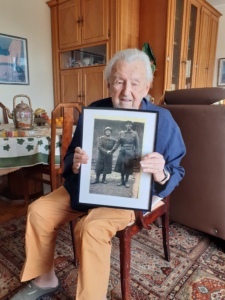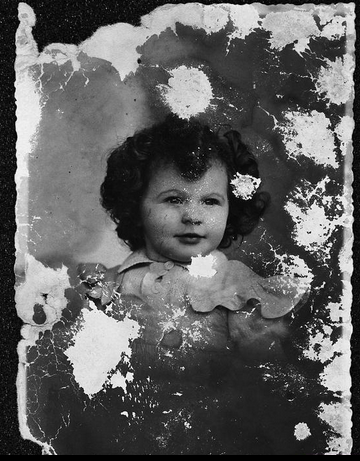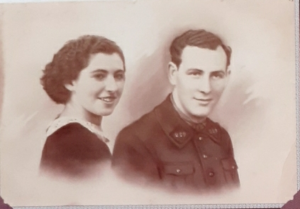Eugénie YAHIA
Hello,
My name is Anna Tostivint. I’m a 15-year-old 9th grader at the François Villon junior high school in Saint-Fargeau-Ponthierry in the Seine-et-Marne department of France.
I’ve long been interested in the history of the Holocaust. I’ve read books and watched films about it and also visited various memorial sites, including internment camps such as Les Milles and Drancy, the Pithiviers railroad station and Mont Valérien. I did my work placement at the Shoah Memorial in Paris in December 2022.
I became interested in the Convoy 77 project and came up with the idea of writing the biography of a person who was deported on this convoy. I was assigned a girl called Eugénie Yahia and began working on her life story. Laurence Klejman, the Convoy 77 project historian, helped me with my research, as did Bernard Grouman, Eugénie’s uncle, whom I was lucky enough to meet. I then had the opportunity to present Eugénie’s life story to my classmates during a history class.
Here is Eugénie’s story:
I. Before the war
1. Background
Eugénie was the eldest daughter of Samuel et de Suzanne Yahia.
a) The paternal branch of the family
The Yahia family was originally from Turkey. The parents, Elie Yahia and Eugénie (or Signorou) Béhart, had three children, the first two of whom were born in the Orta district of Constantinople. Léon Yahia was born in 1912. In 1936, he was working as a confectioner. Samuel Yahia was born on March 7, 1913, while Sarah Yahia was born in 1917, both in Libecht, a town that I have been unable to find on a map of Turkey. The Yahia lineage began when Elie was born in 1877. His parents, Michel Yahia and Sarah Merkada, joined forces with the Béhart family, which was made up of Yoda Béhart, the father, and Djoya Dgaedeti, the mother, when their children, Elie and Eugénie, got married in September 1908. It was a religious wedding and the witnesses were David Alkaher and Aaron Mizrahi.
They emigrated to France sometime before 1924 and settled in Lille, where they lived in an apartment at 129 rue Nationale. Elie was a street vendor.
In 1924, Samuel, like his parents before him, moved to France. After a short stay in Paris, where he lived at 3, impasse Popincourt from 1924 to May 15, 1925, he moved in with his parents in Lille. He worked at several jobs: errand boy, plumber’s apprentice and storeman, before setting up on his own as a street vendor, like his father. He sold gloves.
Elie Yahia died on February 23, 1929, at the age of 51. Samuel thus became the family’s only breadwinner. His mother was in poor health, his brother Léon was unable to hold down a permanent job, and his sister Sarah ran the household.
b) The maternal branch of the family
David Grouman, who was born in 1893, and Sura Fuks, born in 1892, came from Poland, where Szanjdla, (Suzanne in French), the eldest of the siblings, was born in Warsaw on August 17, 1919. They moved to France when Suzanne was a child. They lived for some time in Lille, in the north of France, where Bernard, the second sibling, was born on July 11, 1924. France was short of miners at the time, so David went to work in the mines to help him integrate into French life. Before long, he became a house painter. They then moved to Paris, where the other siblings were born. Marie was born in 1927, Ida in January 1931 and Isaac on February 19, 1933. They lived at 12 impasse Saumon, in the 20th district of Paris. The street is no longer there, however, as it was demolished because the houses were deemed unfit to live in.
The children went to a school at 9 rue Tlemcen. Bernard started in October 1930 and left on January 22, 1938. He was described as a good student. He passed his elementary school certificate with honors in June 1937. Suzanne started at the girls’ school in 1931, followed by Marie in 1933 and Ida in 1937. The register mentions that Marie was “a fairly intelligent child, but very unruly, who caused a great deal of trouble”.
According to Léon Zyguel, who was a neighbor of theirs in 1936, impasse Saumon was in a working-class neighborhood steeped in class consciousness. The Grouman family, in particular the father, David, and Suzanne’s brother, Bernard, were involved in the Communist Party. Suzanne was a member of the Communist girls’ youth movement, the UJFF.
Nine members of the Zyguel family all lived in a two-room apartment with a kitchen and toilet in the courtyard. The Grouman family no doubt lived in a similar situation. The atmosphere was friendly nonetheless, according to Léon Zyguel. The two families became friends, and Léon’s mother Rachel Zyguel was a witness at Suzanne’s wedding.
c) Samuel and Suzanne’s wedding
Samuel and Suzanne got married on December 23, 1937, in the 20th district of Paris. The witnesses were Suzanne’s uncle Léon Grouman, a house painter, and her neighbor, Rachel Zyguel. The religious wedding ceremony and the reception were held in Lille. According to Suzanne’s brother Bernard, Sura took it badly when she found out that her daughter was engaged to a Turk. For Suzanne, however, it was a love match: Samuel was “a handsome young man”.
Suzanne and Samuel as newlyweds.
2. Their time at 129 rue Nationale in Lille
Eugénie was born on at 10:10 a.m. on August 20, 1938. She weighed just over 7lbs. She lived with her parents and paternal grandmother at 129 rue Nationale in Lille. The Milisse family, also originally from Turkey, also lived at this address. The head of the family was a street vendor. They may have been related to the Yahia family. Eugénie’s neighbors were all of humble means. In 1936, the census listed a fur worker, a mechanic, a clerk, an embroiderer and a storeman. The Yahia and Milisse families were the only ones of foreign descent.
The building at 129 rue Nationale belonged to a Miss Guemonprez. Eugénie’s grandmother always paid the rent.
On September 1, 1937, Samuel was naturalized as a French citizen, although his brother Léon’s application had been rejected in 1935.
On February 24, 1938, Samuel’s apartment was burgled: two parcels of gloves were stolen, to the value of 1,500 francs, which was a significant sum in those days.
II. The Second World War
1. Samuel was mobilized for military service
Since he had been naturalized as a French citizen, Samuel had to do military service. He was called up for on September 1, 1939, and assigned to the 39th Infantry Regiment. He was drafted on September 16, 1939. He spent some time in hospital from January 8 to 13, 1940, however, and then went back into the army on April 18, 1940. In 1941, he was taken prisoner of war and held at Frontstalag 192 in Laon. The naturalization review board looked into his case on March 18, 1941 (although the decision was deferred because Samuel was a prisoner of war at the time). He was demobilized on October 29, 1941, but remained a prisoner of war, possibly in a different Frontstalag.
While Samuel was away, Suzanne’s brother Bernard took over the glove business. He returned to Paris with Suzanne and Eugénie in May 1940 and they moved into the apartment on impasse Saumon.
When Samuel was discharged for medical reasons in 1942, Suzanne and Eugénie went back to live with him in Lille. However, although they were French citizens, Samuel and Suzanne felt uneasy. They opted to move to the Southern Zone, which was not occupied by the Germans. Suzanne was pregnant at the time.
2. Samuel and Suzanne were arrested
According to Bernard Grouman, the German police arrested Samuel and Suzanne at La Rochefoucauld on November 5, 1942, for crossing the demarcation line illegally. This was probably as a result of a tip off from the people smuggler who was supposedly helping them. La Rochefoucauld was the main crossing point into the Free Zone and the only place that it was possible to cross the line by train. They were taken to the Angoulême prison. They stayed there until November 18, 1942, when they were transferred to the camp on the Limoges road in Poitiers.
a) Samuel was deported first
Suzanne was admitted to the Poitiers maternity hospital on January 7, 1943. This was very early in her pregnancy, given Jacqueline’s date of birth. Sending her to hospital was a way of keeping her safe. It meant, however, that Samuel never even met Jacqueline, his second daughter, who was born on February 17: he had already been transferred to Drancy on January 29, 1943. This was the seventh time he had been transferred. In Paul Lévy’s book, Elie Bloch: être juif sous l’Occupation (Elie Bloch: being Jewish during the Occupation), it says that while the Samuel and Suzanne Yahia were in the Poitiers camp, they stayed in the same area of the barracks as Rabbi Elie Bloch’s wife, Georgette, who was arrested on January 22, 1943. “Everyone got along very well together”. “When the list came out, it was a shock: those who were leaving entrusted their possessions or their families to people who were staying on”, “Yahia gave me some recommendations for his wife and daughter, I couldn’t hold on any longer, I cried for the first time in the camp”, wrote Georgette Bloch.
On March 9, 1943, Samuel arrived in the Beaune-la-Rolande camp. He was then transferred to Drancy on March 23, from where he was deported to Sobibor on Convoy 53 on March 25, 1943.
But what happened to Eugénie? There is no further mention of the Yahia family in Georgette Bloch’s correspondence. Did she stay on alone in the camp, without her father or her mother, who was in the maternity hospital? The camp registers state that she was liberated on March 15, 1943, but where did she go? Was she placed with a foster family?
b) Jacqueline was born
Suzanne gave birth to Jacqueline at 4:25 a.m. on February 17, 1943. Jacqueline weighed just over 7lbs and was 19″ long. Suzanne breastfed her baby. They spent 76 days in the Poitiers maternity hospital and were discharged on March 24, 1943, at which time their condition was reported to be “satisfactory”.
c) Suzanne and Jacqueline were deported
They were both transferred to Drancy on May 26, 1943. Jacqueline was not yet three months old. According to Paul Lévy, she was the youngest child on this transport. Did Eugénie go with them? According to the Drancy transfer logs, Eugénie indeed was with her mother and sister when they arrived at Drancy on May 27, 1943. Two days later, Suzanne and Jacqueline were admitted to the Rothschild hospital for reasons unknown. There, Suzanne met up with Rosa Dembicer and her baby Jacques, who were in hospital at the same time. The two families must have known each other since their time in the Poitiers camp.

In this photo, taken at the Rothschild hospital, Suzanne is in the center with Jacqueline on her lap. Jacqueline is the baby on the left. A nurse at the hospital sent the photo to the family.
Suzanne and Jacqueline were discharged from hospital on July 5. Thirteen days later, they were deported to Auschwitz on Convoy 57. Jacqueline was six months and one day old. The earliest age at which a baby could be legally deported was six months: the Nazis could not even wait two days to deport her.
3. The UGIF homes
On June 9, 1943, a request was made for Eugenie to be released: she was taken in by the UGIF (Union Générale des Israelites de France, or Union of French Jews). She was transferred to the Lamarck children’s home at 21 rue Paul Albert in the 18th district of Paris. She was then admitted to the Claude Bernard hospital as she had mumps, a contagious disease. She was cared for in the Pavillon Davaine, where she stayed from June 12 to July 12, 1943.
She went back to the Lamarck home and then to another UGIF home in Neuilly (known as Center 40). This home took in babies and young children. On September 20, Eugénie left Neuilly and returned to the Lamarck home.
On October 12, 1943, she left the Lamarck home again and was sent to the Louveciennes home in the Yvelines department. Denise Holstein, a Holocaust survivor, was an instructor at Louveciennes and looked after the youngest children. In her testimony she says that she remembers Eugénie, who often cried at bedtime and called out for her mother.
There is no record of Eugénie in the Louveciennes school registers.
4. The children in Louveciennes were arrested
At the end of July 1944, Aloïs Brunner, the commandant of the Drancy camp, decided to all the children in the UGIF homes in and around Paris. Denise Holstein recounts how the Germans surrounded the building and how the children had to quickly gather their belongings and were then put on a bus to Drancy, where they stayed until July 31, 1944.
5. Convoy 77
Convoy 77 was the last transport to leave Bobigny station for Auschwitz, with 1,306 deportees aboard, including 324 children. 125 of them were under 10 years old, 18 of them babies. 223 children were rounded up in UGIF homes in and around Paris. In most cases, their parents had already been deported, but the children did not know that.
Eugénie must have travelled in the same cattle car as Denise Holstein, who looked after the young children. She recounts the extremely tough journey: the heat, the thirst, the lack of sanitation, the adults’ hostility to the children. She took care of the children as best she could, taking turns letting them breathe fresh air through the tiny opening high up in the cars. The children could not sleep, and when eventually they did, the train stopped. They had arrived at Auschwitz.
The Germans snarled their orders as the children got off the train. Eugénie must have been with the other children from Louveciennes when they were loaded onto trucks and taken to the gas chambers.
None of the children from Louveciennes who were deported to Auschwitz ever came back.

Memorial plaque at Louveciennes.
Eugénie’s name is inscribed on the memorial plaque in Louveciennes and on the memorial in Lille.
III. What became of the survivors?

Bernard Grouman at his home on June 11, 2022, holding a photo of himself and a friend.
Bernard and his father, David, were the only members of the Grouman family who were not deported. They avoided the Vel’d’Hiv roundup by going into hiding. They thought at the time that only men were at risk.
Bernard was a member of the Communist resistance movement until the end of the war. He joined a group in the Vercors mountains and took part in the liberation of Grenoble and Lyon. His mother, Sura, was deported on Convoy 13 on July 31, 1942. His brother and sisters, Isaac, Ida and Marie, were deported on Convoy 23, August 24, 1942.
I have been unable to find out anything about what happened to Samuel’s family after the war.
See also the biographies of Cécile DEMBICER and Simon DEMBICER


 Français
Français Polski
Polski











